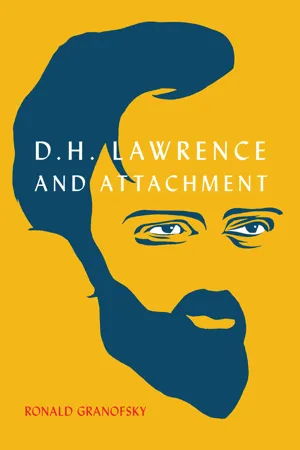
- English
- ePUB (mobile friendly)
- Available on iOS & Android
D.H. Lawrence and Attachment
About this book
Though we all face a tug of war between dependency and autonomy while growing up, British author D.H. Lawrence (1885–1930) experienced the struggle with particular intensity. Later in life, his acute observational skills, high emotional intelligence, and expressive abilities would allow him to articulate this conflict in his works as few other writers have.
Applying concepts from attachment theory, D.H. Lawrence and Attachment presents innovative readings of a broad swath of Lawrence's fiction. Ronald Granofsky teases out hidden patterns in Lawrence's work, deepening our understanding of his fictional characters and revealing new significance to key thematic concerns like gender identification, marriage, and class. Lawrence's too-close relationship with his own mother, in particular, was the foundation for his lifelong interest in attachment, as well as the impetus for his literary exploration of the delicate balance between the desire for closeness and the need for separation. While the theories of Margaret S. Mahler, D.W. Winnicott, John Bowlby, and others were developed after Lawrence's death, his writing about relationships - and how they are influenced by early childhood experiences - bears a striking resemblance to the concepts of attachment theory.
The Lawrence who emerges from D.H. Lawrence and Attachment is a psychological writer of great power whose intuitive insights into the vagaries of attachment resulted in rich, complex fiction.
Frequently asked questions
- Essential is ideal for learners and professionals who enjoy exploring a wide range of subjects. Access the Essential Library with 800,000+ trusted titles and best-sellers across business, personal growth, and the humanities. Includes unlimited reading time and Standard Read Aloud voice.
- Complete: Perfect for advanced learners and researchers needing full, unrestricted access. Unlock 1.4M+ books across hundreds of subjects, including academic and specialized titles. The Complete Plan also includes advanced features like Premium Read Aloud and Research Assistant.
Please note we cannot support devices running on iOS 13 and Android 7 or earlier. Learn more about using the app.
Information
Table of contents
- Cover Page
- Title Page
- Copyright
- Dedication
- Contents
- Acknowledgments
- Cue Titles
- Introduction: Equilibrium and the Lawrentian Paradox of Attachment
- 1 Abandonment Anxiety
- 2 Gender Identification
- 3 Marriage
- 4 Class
- 5 Stories of Homecoming
- Conclusion: The Other Side of Otherness
- Notes
- Works Cited
- Index